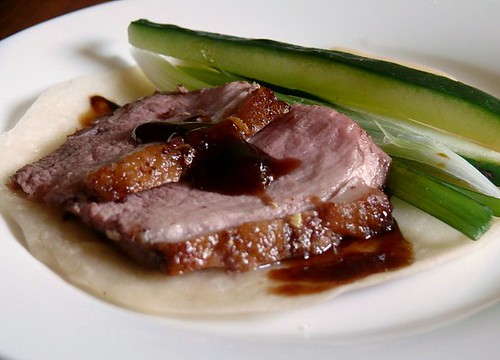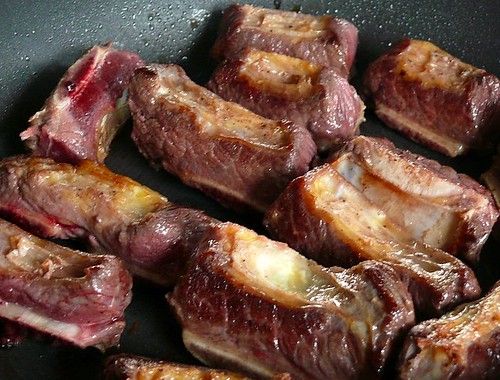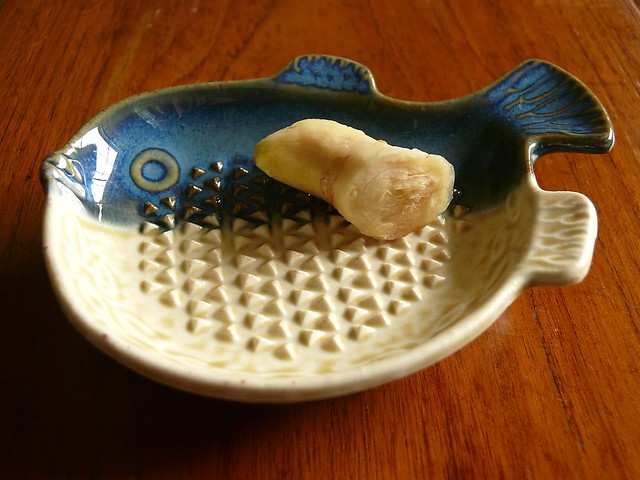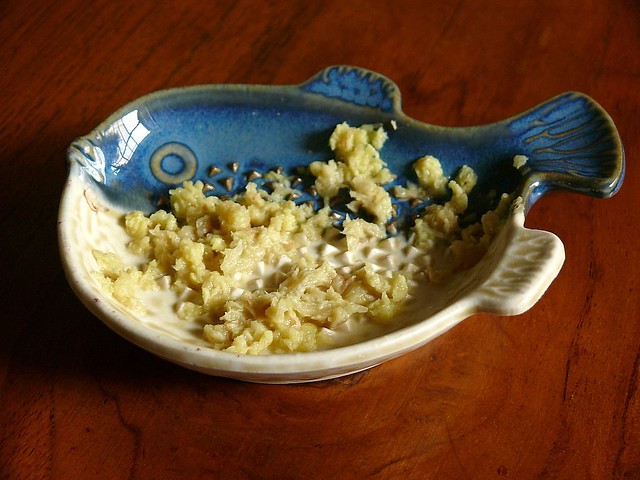
Pan-fried to render the oil and finished in the oven to crisp the skin.

Duck breast with hoisin plum sauce.

Duck breast on pancakes, a la Peking Duck style.
Today's a public holiday, the Ka'amatan or Rice Harvest Festival. For lunch, I cooked duck breasts with hoisin-plum sauce. This was the second time I cooked duck breasts. It was only recently that I found duck breasts at Hong Seng, the cold storage mart in Damai. At about RM8/USD2.60 per piece, duck breasts are much cheaper than beef or lamb. And easier to cook and fancier too.
The first time I cooked duck breasts, I pan-fried them until they were nearly done. The meat was slightly pink, moist and sweet. This time, I decided that frying four breasts in two batches just takes too long so I fried them until half-done (7 minutes each side) and finished them in the oven. However, I was distracted and the breasts were in the oven for a good 20 minutes instead of 7 minutes. Duck breasts, as you know, are best slightly underdone. Anyway, although the duck breasts were a slight disaster, my Peking duck pancakes were good-- they popped apart. That was great, because I've always had difficulty pulling the pancakes apart. Now I know that the reason my pancakes were always stuck together was because they were underdone. That, or maybe because they used to stick together because I've always used my finger to smear oil on the pancakes but this time I used a brush. Oh, and another good thing about today's cooking experiment was that I found that potatoes fried in duck fat is heavenly! I saw cans of duck fat in Europe and imagined that they were rather gross, but oil rendered from the duck breasts didn't smell ducky at all and somehow made better potatoes than even butter. Wow. I actually preferred the potatoes in duck oil to the duck.
Duck Breasts In Hoisin-Plum Sauce
One breast per person is good. Score the skin (for easier rendering of the fat) and pan-fry the breasts, skin-side down, two each time, without any oil in the pan. In no time, the breasts will be swimming in oil. Halfway through, after 7 minutes on each side in medium heat (I actually cooked the breasts on low heat but I think medium heat will render even more fat out and make the skin crispier), season the breasts with coarse salt and pepper (black or white or even Sichuan peps is good), pop the breasts into the pre-heated oven at 200 C for another 7 minutes or so. Remove and let rest for 5 minutes. Slice thinly (mine were too thick). Spoon some sauce onto a plate, place duck slices over the sauce and serve. If serving with potatoes, boil the potatoes until just done, cut into smaller pieces and then fry in the rendered duck oil until golden. Season with salt and pepper.
For the sauce, just heat 1 spoon of hoisin sauce with 1/2 spoon of plum sauce for one breast.
Peking Duck Pancakes
1. Put 1 cup plain flour into a bowl and add 1/4 cup boiling water. Stir quickly with a pair of wooden chopsticks or fork, until small lumps form. After 30 seconds of cooling, gather dough into a ball and knead until smooth. If too sticky, add more flour and if too dry, add a little bit more water. Cover and let dough rest about 30 minutes.
2. Roll dough into a long cylindrical shape and break into even number of small pieces about twice the size of your thumb. Dust well with flour.
3. Take two pieces of dough, roll each into a ball and press to flatten into a disc/circle. Brush oil liberally (veg or sesame oil) on one disc and press the other piece on top, placing it slightly askew so that it'll be easier to see when you pull them apart. This is a very clever space-saving way of frying two pancakes at once, allowing more pancakes to be fried.
4. Roll (make sure not to press too hard or pancakes'll not pull apart easily) into a thin pancake and fry, without oil, in a non-stick pan until it turns slightly transparent on both sides, about 1 minute each side over low heat. Do not fry until golden or scorched. When cool, pull apart. Keep covered with a cloth as you work on the rest of the dough.











